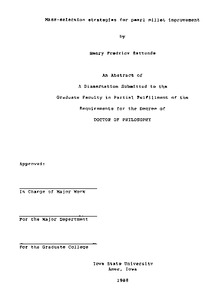Mass-selection strategies for pearl millet improvement
Abstract
Mass selection is frequently used for genetically improving pearl millet (Pennisetum slaucum R. Br.). To ascertain the ability of mass selection to modify traits of agronomic importance to pearl millet, this study determined (a) the heritability and interrelationships of those traits and (b) the realized gains obtained from selection. SO and S 1 populations of three pearl millet composites were evaluated for an array of agronomic and developmental traits. Parent-offspring heritability values ranged from 0.46 to 0.64 for panicle size and seed traits, from 0.27 to 0.58 for productivity traits, and from 0.16 to 0.32 for partitioning traits, when averaged over three pearl millet composites. Interrelationships among traits were identified by factor analyses and found to be similar in the three composites. Unique groups of traits were associated with biological yield, panicle size, and seed factors. Certain traits, however, were associated with both the biological yield and the partitioning factors. The orientations of S plants along the biological yield, 0 panicle size, and seed parameters factors were siqnificantly related to orientations of their S progenies along the correspondinq factors

